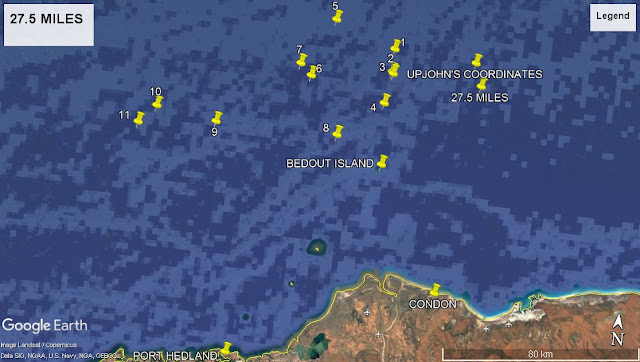In regard to the reported remarks
by Capt. Allen that he did not think
he would make port before the Saturday
following, Mr. Gardiner states
that what the master of the Koombana
meant was that if he could not get into
port at noon on the due date
with the midday tide he would not
be able to berth till 24 hours later
with the following tide.
Koombana was a powerful steamer capable of 15 knots. Captain Allen's prediction revealed and disclosed that he was not anticipating an average speed of more than 10 knots against gale force winds from the NE and heavy seas (pitching = decreased thrust), confirming concerns about weather conditions.
Mr. Moxon also read a number of
reports from pearlers and others in
the Nor'-West on the state of the
weather. In the reports it was stated
by some (referring to Bedout Island)
that the light on the island, which
was a self -attended one, was not
alight on March 13 and 15.
A FULL WEEK BEFORE THE DISASTER!
- Mr. Moss : The ship was installed
with wireless telegraphy?
- I understand that some ships
spoke to the Koombana by wireless
on the night of March 19?
— That is so. The Riverina was in
communication with the Koombana on the
night of March 19, the former vessel
being near Albany. The German
Australian steamer Adelaide (Gneisenau)
also reported having been in touch with
her, but no ship appears to have
spoken to the Koombana after that
- Would the Marconi operator be
on special duty on an occasion such
as the time of a hurricane
— An operator would be on special duty.
No one would be able to interfere
with him in duty.
The Marconi operator, Lyon was inexperienced and the set had required attention before departure from Fremantle due to some undisclosed fault. These two factors might have presented challenges during a crisis. Moreover, Marconi operators on board steamers of this era were not employed by the shipping company nor directly accountable to the captain of the vessel regarding shifts. Lyon might already have retired if the disaster occurred late into the night.
The chief harbour master (Captain
C. J. Irvine) was called by Mr. Parker
to give some information to the
court concerning the light on Bedout
Island. Captain Irvine said that he would
tell the court the reason why that
particular class of light had been
placed on Bedout Island. It had
been pointed out to the Government
that a light was required for Bedout
Island, but as the island was very
dangerous, especially in the hurricane
season, the department had received
advice as to the means of securing a
light that would burn for some time
unattended.
The matter was given thorough attention,
and the department had secured an
unattended light, which it was estimated
would burn 12 months without attention.
The light, however, would not be left that
long without being visited. It was first
lighted on December 10, 1909, and up to
the recent fault recorded the lamp had
















